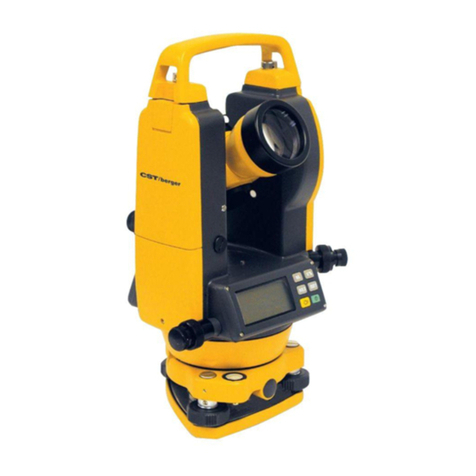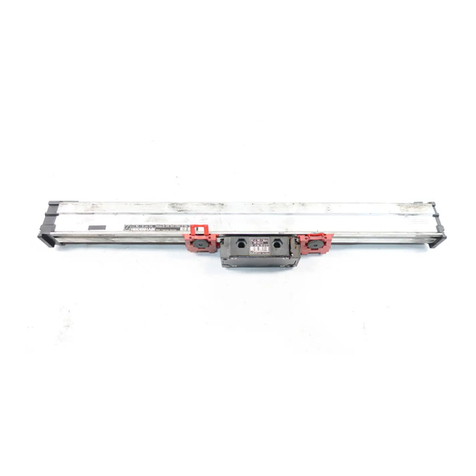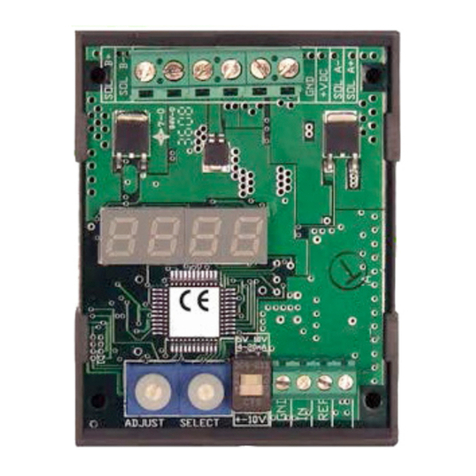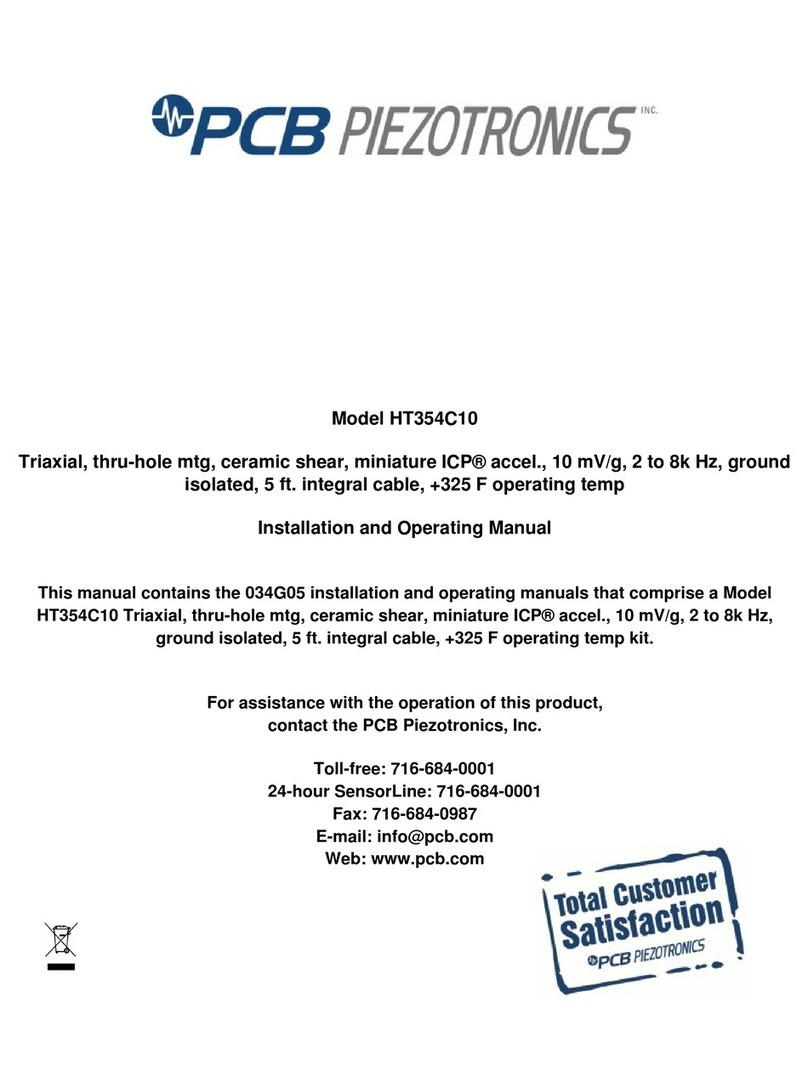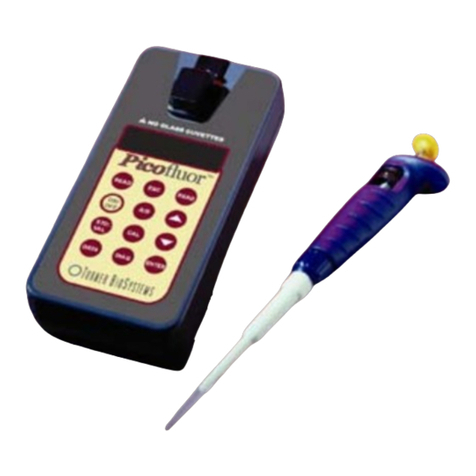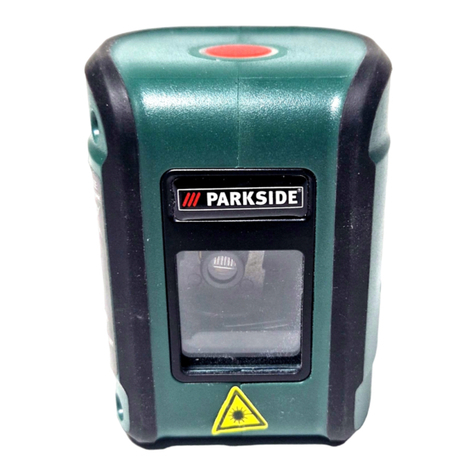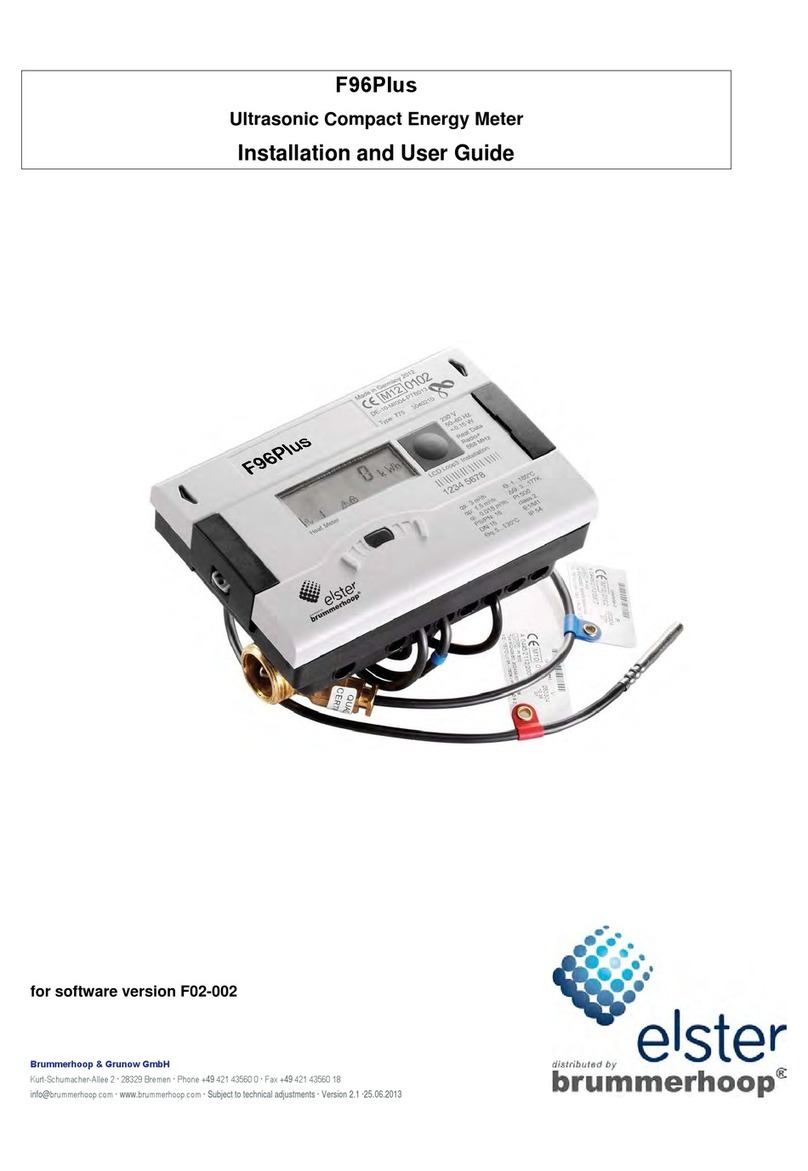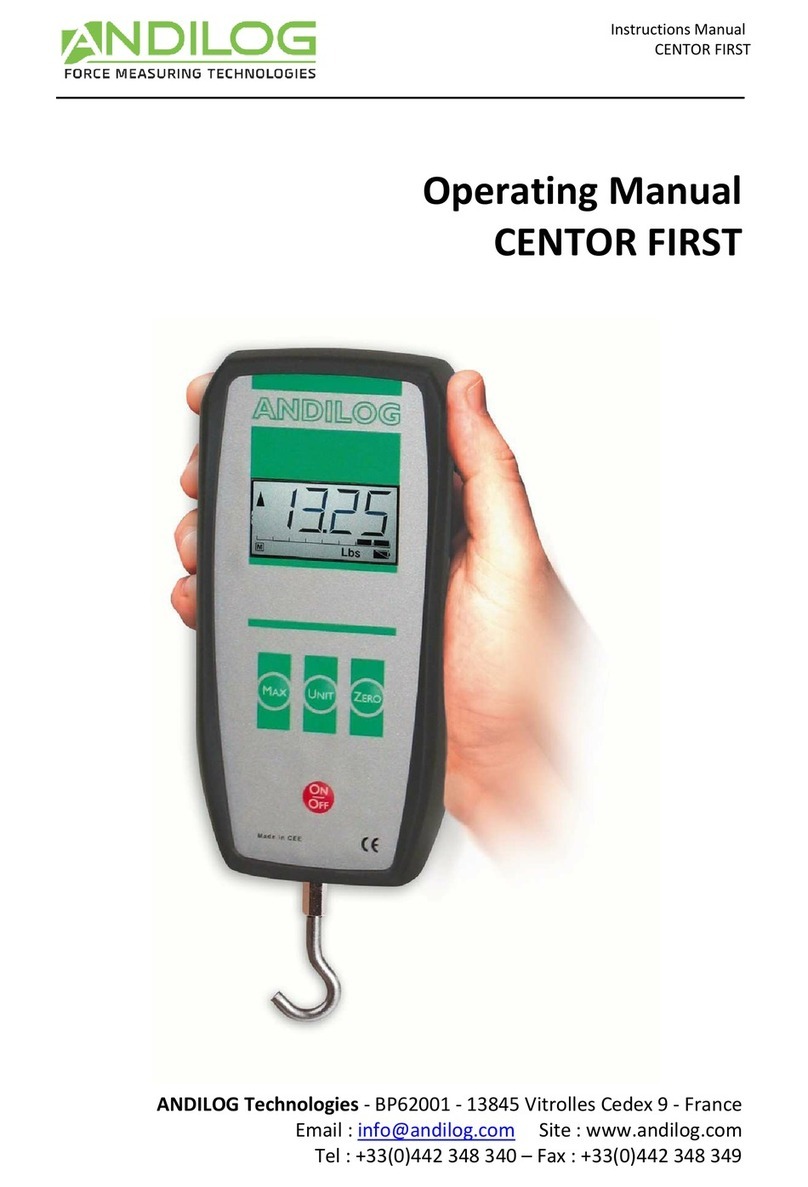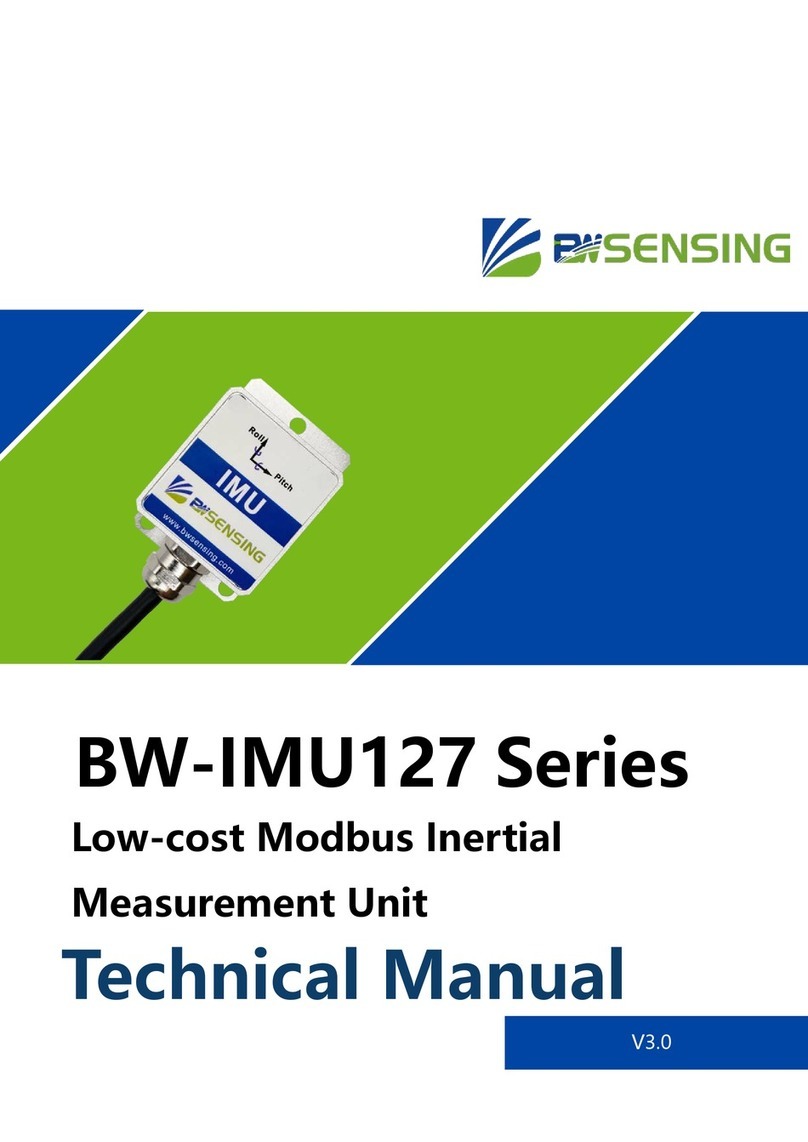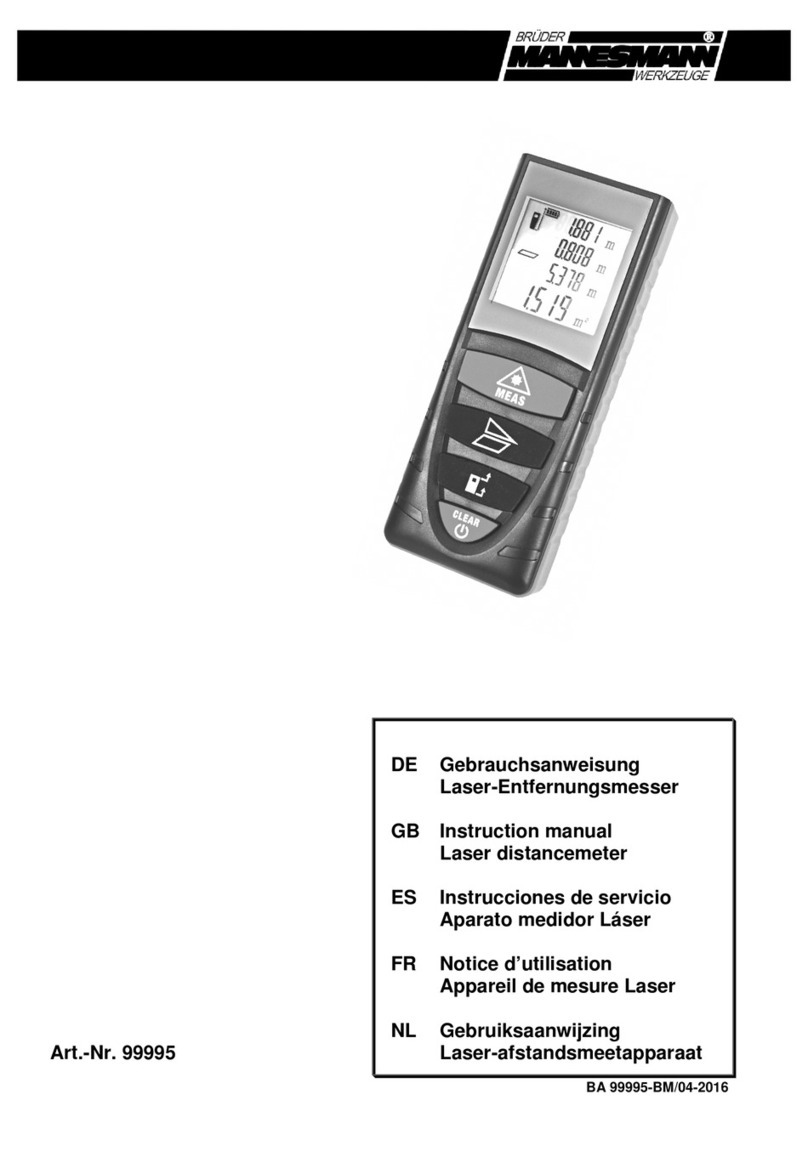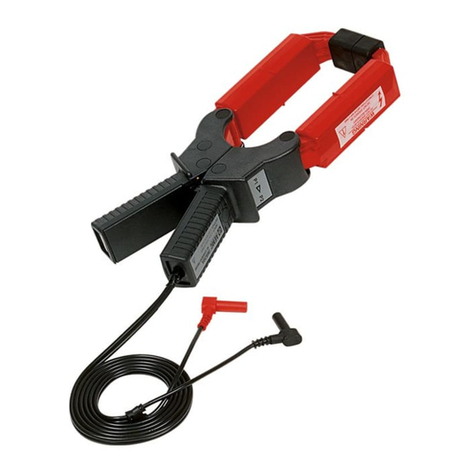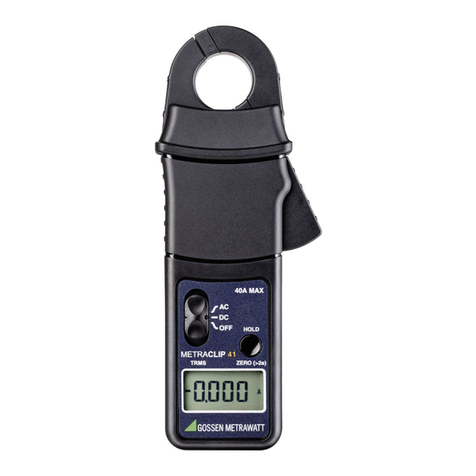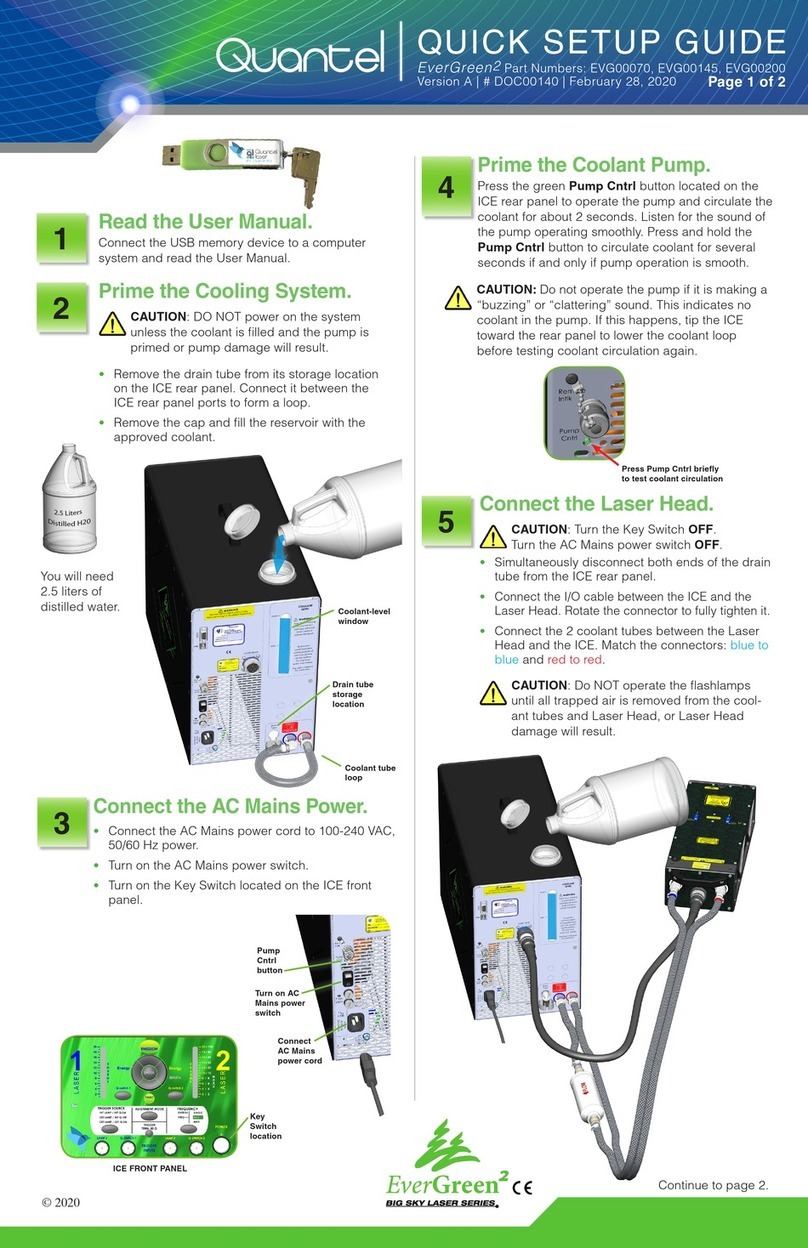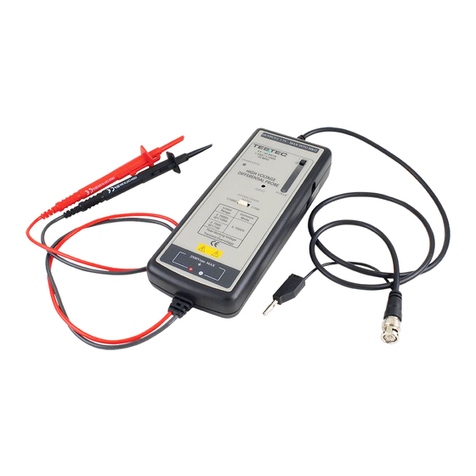CST/BERGER LMH600 User manual

Electronic Self-Leveling
Electronic Self-Leveling
Rotary Laser
Rotary Laser
Instruction Manual
Manual de Instrucciones
Manuel d’Instructions
Manuale di Istruzioni
Bedienungsanleitung
Instruções de Utilização
Electronic Self-Leveling
Rotary Laser
models:
LMH600, LMH-CU
LMH-CU
LMH600
LMH600 Self-Leveling Rotary Laser
3
Electronic Self-Leveling
Rotary Laser
www.cstberger.com
3

2 • LMH-SERIES

LMH-SERIES • 3
Electronic Self-Leveling
Rotary Laser
3
2

4 • LMH-SERIES
LMH600 Self-Leveling Rotary LaserLMH600 Self-Leveling Rotary Laser
Fig. 4
LMH600 Self-Leveling Rotary Laser
Fig. 5
LMH600Self-LevelingRotaryLaser
Fig. 6
VERTICAL LINE
LMH600 Self-Leveling Rotary Laser
PLUMB BEAM
Fig. 7
Y-Axis
Y
“MORE”
X
“MORE”
(K)
(J)
(H)
(I)
“LESS” “LESS”
LMH600 Self-Leveling Rotary Laser
LMH-CU Errors
LMH600 Errors
X—AXIS ERROR
Y—AXIS ERROR
SPINDLE ERROR
X—AXIS ERROR
Y—AXIS ERROR
SPINDLE ERROR
Fig. 8
Fig. 9
Fig. 10

LMH-SERIES • 5
Thank you for purchasing the CST/berger LMH-Series Automatic Electronic
Self-Leveling Rotary Laser Level. Please read this manual thoroughly before operation
MODELS
LMH-CU LMH-CU Visible Horizontal Beam Electronic
Self-Leveling Rotary Laser.
LMH600 LMH600 Visible Horizontal/Vertical Dual-Beam Electronic
Self-Leveling Rotary Laser; Dual Manual Slope.
Copyright© 2008 CST/berger. All rights reserved
The information contained herein is proprietary information of CST/berger, and is subject to change
without notice. This document shall not be copied or otherwise reproduced without CST/berger's
written consent.
SAFETY AND CERTIFICATIONS
Working safely with this instrument is possible only when the operating and safety information are
read completely and the instructions contained therein are strictly followed.
The use of controls, adjustments, or the performance of procedures other than those specified
herein may result in hazardous radiation exposure.
Do not stare into the laser beams. Do not direct the laser beam at other persons. Do not
disassemble the instrument or attempt to perform any internal servicing. Laser class is indicated
on the instrument.
Repair and servicing of this laser are to be performed only by CST/berger or authorized
service centers.
This laser complies with all applicable portions of title 21 of the Code of Federal Regulations set by:
the Dept. Of Health, Education, and Welfare; the Food and Drug Administration; the Center for
Devices; and the Bureau of Radiological Health.
The laser has also been tested and complies with the CE certification requirements set forth in the
EC regulations 89/336/EEC and EN 61000-6-1 (EN50082-1), EN 61000-6-3 (EN50081-1) and IEC 60-825-1.
ACCORDING TO IEC/EN 60825-1: 2007
EN
ACCORDING TO IEC/EN 60825-1: 2007

6 • LMH-SERIES
LASER SAFETY
WARNING: Be sure to read and understand all instructions in this manual before using this
product. Failure to follow all instructions may result in hazardous radiation exposure,
electric shock, fire, and/or bodily injury.
CAUTION: Use of controls or adjustments or performance of procedures other than those
specified in this manual, may result in hazardous radiation exposure.
CAUTION: The use of optical instruments with this product will increase eye hazard.
IMPORTANT: The following labels are on your laser for your convenience and safety. They indicate
where the laser light is emitted by the level.
ALWAYS BE AWARE of their location when using the level.
ALWAYS make sure that any bystanders in the vicinity of use are made aware of the dangers of
looking directly into the laser.
DO NOT remove or deface any warning or caution labels. Removing labels increases the risk of
exposure to laser radiation.
DO NOT stare directly at the laser beam or project the laser beam directly into the eyes of others.
Serious eye injury could result.
DO NOT place the laser in a position that may cause anyone to stare into the laser beam
intentionally or unintentionally. Serious eye injury could result.
DO NOT use any optical instruments such as, but not limited to, telescopes or transits to view the
laser beam. Serious eye injury could result.
ALWAYS remove the batteries when cleaning the laser light aperture or laser lens.
DO NOT operate the laser around children or allow children to operate the laser. Serious eye injury
could result.
ALWAYS turn the laser OFF when not in use. Leaving the laser ON increases the risk of someone
inadvertently staring into the laser beam.
DO NOT operate the laser in combustible areas such as in the presence of flammable liquids,
gases or dust.
ALWAYS position the laser securely. Damage to the laser and/or serious injury to the user could
result if the laser falls.
ALWAYS use only the accessories that are recommended by the manufacturer of your laser. Use of
accessories that have been designed for use with other rotary lasers could result in serious injury.
DO NOT use this laser for any purpose other than those outlined in this manual. This could result in
serious injury.
DO NOT leave laser ON unattended in any operating mode.
ALWAYS repair and servicing must be performed by a qualified repair facility. Repairs performed
by unqualified personnel could result in serious injury.
DO NOT disassemble the laser. There are no user serviceable parts inside. Disassembling the
instrument will void all warranties on the product.
DO NOT modify the product in any way.

LMH-SERIES • 7
LMH600 Self-Leveling Rotary Laser
Electronic Self-Leveling
Rotary Laser
LMH600LMH-CU
3
FEATURES
Low Battery Indicator
Anti-Drift System
Single Slope/Grade
Dual Slope/Grade
Dual-Beam
Scanning Angle
Feature
Directional Head
Positioning
Variable Speed
Rotation
LayDown Auto-beam
Positioning

8 • LMH-SERIES
3
Electronic Self-Leveling
Rotary Laser
A
B
B
C
D
E
G
F
H
I
J
K
LMH600
LMH-CU
FEATURES - Fig. 1 , & 2 ICONS
1. Self-Leveling Rotating Laser Head. (With vertical
visible dual-beam LMH600 only)
2. Battery Low LED Indicator Light
3. Anti-Drift System LED Indicator
4. Power ON/OFF LED Indicator
5. Manual Grade Adjustment Buttons (LMH600)
6. 5/8 - 11 Tripod Mounting Threads (for level work)/
Battery pack.
7. Heavy-Duty Handle
8. Vertical Beam (LMH600 only)

LMH-SERIES • 9
LMH-CU Fig. 1
7
6
1
3
4
2

10 • LMH-SERIES
LMH600 Fig. 2
7
LMH600 Self-Leveling Rotary Laser
6
1
3
4
2
8
5
LMH600 Self-Leveling Rotary Laser

LMH-SERIES • 11
Electronic Self-Leveling
Rotary Laser
3
LMH600 Self-Leveling Rotary LaserLMH600 Self-Leveling Rotary Laser
LMH600 Self-Leveling Rotary LaserLMH600 Self-Leveling Rotary Laser
NOTE: Setup a Benchmark
During the work day, periodically check your initial
setup to ensure that the laser reference
has not moved.
Establish, at a suitable distance (furthest possible), a
benchmark (reference) on a stable surface (ie. tree,
building). Periodically during the work day, check the
benchmark to ensure that your setup has not moved.
APPLICATIONS
Benchmark.
Professional grade Accuracy
and Durabillity for general
construction and site preparation
jobs.
Including;
• Grading and excavation
• Porch and deck construction
• Driveway paving
• Exterior siding
• Marking elevation
• Landscaping
• Pool installation
• Fencing
• Masonry work
• Concrete forms
• Machine control
• Building room addition
• Remodeling
• Walls and partitions
• Acoustical ceilings
Exterior- LMH-CU, LMH600
Interior-LMH600

12 • LMH-SERIES
Operating Instructions for General Construction Applications
NOTE: A level plane of laser light is created by the rotating beam of the laser. The laser light can be
used to reference elevations with the use of a laser detector. (Fig. 4)
1. Place the instrument on a flat, level surface such as a tripod. Setup the instrument in an
area where it can not be obstructed and is set at a convenient height.
2: Press the (A) button. Allow the instrument to self-level.
3. Setup a Benchmark.
4. LMH600 Only – Set the Variable Speed Rotation (page 13) to the desired
rotation speed of the laser head. Ideal speed for use with laser detector is 600 RPM.
5. Take elevation readings using the plane of laser light as a reference. Follow the Detector
Operation Procedures in this manual.
Ceiling Grid Applications
1. Attach the laser to the optional wall-mount bracket. Be sure the control buttons are facing
outward. Tightening the locking screw will secure the instrument to the bracket.
2. After installing the first piece of ceiling trim, attach the wall-mount to it. Be sure the
wall-mount is secure to the trim.
3. Press the (A) button. Allow the instrument to self-level.
4. Adjust the distance of the instrument from the grid, typically 1.5-inch (38mm) below the grid.
Loosen the adjustment screw and slide the instrument up/down on the wall mount. When
the desired height has been reached, tighten the adjustment screw to secure the instrument.
5. Setup a Benchmark (page 11).
6. Install the ceiling grid. Attach the magnetic laser target to the ceiling trim being installed.
Adjust the height of the trim until the laser beam strikes the target.(Fig. 5)
Laydown Applications (LMH600 only)
1. Place the instrument in the laydown position on a flat, level surface.
2. Press the (A) button. Allow the instrument to self-level.(Fig. 6)
3. Setup a Benchmark (page 11).

LMH-SERIES • 13
OPERATION
Remove the laser from its carrying case. The instrument is shipped with a battery current
protection insert, which must be removed before operation.
NOTE: All LMH-CU instruments are shipped with ADS on as the default setting. This
setting can be changed by the user (see Anti-Drift System - ADS, page 14).
Leveling
1. The instrument can stand alone on a level, sturdy surface or preferably secured to a 5⁄8-11
surveyor’s tripod.
2. Press the (A) button once, and allow time (up to 60 seconds) for the instrument to self-level.
NOTE: The laser head may begin to rotate before leveling is complete. The self-leveling speed is
approximately 1° per 4 seconds.
3. After self-leveling, the instrument will begin operating in Rotation Mode.
NOTE: The LMH600 will return to last mode of operation (i.e. sweep, spot, or rotation speed);
however, does not retain grade information,
NOTE: After self-leveling, the instrument will begin operating in Rotation Mode for LMH-C.
Plumbing / Lay-Down (Model LMH600)
1. On a flat surface, place the instrument on its back using the built-in trivet (control panel
facing upward) (Fig. 7).
2. Press the (A) button once, and allow time for the instrument to self-level.
NOTE:When the Instrument is placed in the laydown position, the ADS button (B) works either as
ADS button or Auto Beam Positioning button.
3. Enable the Auto Beam Positioning by turning OFF ADS if it is ON, and by placing the
instrument in SPOT mode. (ADS will not be available in Spot mode once it is turned OFF).
4. Press the Auto Beam Positioning (B) button; the laser beam will plumb down over point.
(Reference Only).
5: Use the clockwise (F) and counter-clockwise (G) buttons for fine adjustment.
NOTE: For fine adjustment of the vertical laser plane or of the 90° beam, please refer to Line Position.
Variable Rotation Mode (Model LMH600 only)
The rotation mode will give you the option of increasing or decreasing the speed of the rotating
laser. This feature can be used to create a room-wide, 360° height reference or vertical plumb line
for general alignment, drop ceiling installation, and more.
Pressing the (E) button, will adjust the speed from 600, 300, 150, and 0 RPM.

14 • LMH-SERIES
Sweep or Scanning Mode (Model LMH600)
Instead of creating a room-wide reference line, the Sweep (Scanning) Mode creates a shorter,
brighter laser chalk line that can be used for leveling or plumbing doors, windows, fixtures, and
more. You may also use this feature to keep the instrument from interfering with other lasers and
detectors on site.
Pressing the (D) button, will lengthen or shorten the sweep of the laser beam. Preset angles of 10º,
45º, 90º,180º and spot can be set. Position the sweep area by using the (F) or (G) buttons.
Spot Mode (Model LMH600 only)
Spot Mode creates a motionless laser dot for reference, allowing the instrument to be used as a
straight-line laser.
Press the (E) button until the instrument is in Spot Mode. Press the (F) or (G) to rotate the laser
head clockwise or counter-clockwise. Pressing and holding the (G) or (F) button moves the rotating
beam more quickly.
Re-Leveling
If the instrument is bumped or moved, the instrument will automatically attempt to re-level itself.
On a job site, it may be necessary to prevent re-leveling in order to prevent inaccurate
measurements by the operator. The Anti-Drift System (ADS) is used for this purpose (see Anti-Drift
System - ADS). The instrument can also be placed in Manual Mode to allow the instrument to
continue operating when out of level.
Axis Drive Error
If the instrument is set up or tipped beyond its self-leveling range of ±5°, the laser head will initially
attempt to level; however, when the self-leveling limit is reached, an error will indicate an axis
error (Fig. 8).
Turn the instrument OFF, move the instrument to a more level position, then turn the instrument
on again.
Spindle Motor Error
If the laser spindle motor fails to rotate or rotates outside of the set speed, an error indicator will
indicate a spindle motor error (Fig. 8).
Anti-Drift System – ADS (LMH-CU and LMH600)
The Anti-Drift System, when ON, will signal to the operator that the instrument has been moved out
of level.The laser head will stop rotating, and the beam and ON LED will blink.
The default setting for ADS is user selectable. The default setting may be set to ADS ON or ADS
OFF. When the instrument is OFF, press and hold the (C) button for LMH-CU, or for LMH600 hold (F)
button, and then press the (A) button. Once the instrument is ON, turn the instrument off for 15 sec
and then back ON. If ADS was ON (OFF), it will now be OFF (ON).

LMH-SERIES • 15
To activate ADS, turn off the Manual Mode (if it is ON) by pressing (C), and then press the ADS (B)
button. If after 1 minute, the instrument is disturbed and the ADS light is flashing it is necessary to
check any benchmarks that have been made and ensure the proper "HI" (Height of Instrument).
After the flashing ADS has been reset, by pressing the button one time, you will have an additional
minute to set and check your measurements.
To turn ADS OFF press the (B) button once. This will put the instrument into normal Auto
Self-Leveling mode.
Manual Mode
Manual mode disengages the leveling feature; allowing the instrument to be placed in any position (to
grade). To activate the Manual Mode, Turn off the ADS (if it is on) and then press the MANUAL mode
button. (Note: The instrument should be level and rotating before entering manual mode to eliminate
the possibility of error.) Once the button has been pressed the ADS light will blink three times, pause
and three times again. Press the MANUAL mode button again to return to normal operation. (Note:
When returning to normal operation the unit must be within its leveling range. Re-set the unit to a level
position before pressing the MANUAL MODE button to the off position.
Manual Grade Mode – Dual Axis Grade (LMH600 only)
The dual grade function is ideal for general site grading, checking excavations, landscaping and
drainage, and more (Fig. 9).
Manual grade mode can be activated by placing the automatic leveling sensor in the OFF position.
The selected grade can be as much as a positive or negative 10%.
Pressing the (C) button will deactivate the level sensor. Use the (H) ("MORE") and (I) ("LESS") arrow
buttons, to adjust your desired grade on the Y axis, (J) ("LESS") and (K) ("MORE") for the X axis.
NOTE: If the instrument is bumped or moved while in Manual Grade mode, the instrument will not
re-level itself.
The instrument will react to “MORE” and “LESS” input. Allow the instrument ample time to react to
the input provided, between grade setups or changes (Fig. 10).
Line Position Mode (Model LMH600)
In this mode, the instrument allows you to fine-tune the location of your vertical (plumb) laser line.
For example, if you’ve established a plumb line and find that the line is slightly off to the left or right
of your target, use Line Position to jog the line into place without moving the entire instrument
(useful for floor and wall tile installation, walls or partitions, etc.). The laser will now remain aligned
to your target even if you enter other modes (Rotation, Spot, Point-to-Point).
Model LMH600
Line Position mode is available when the instrument is placed in the plumbing position (control
panel facing upward). While the instrument is in the plumbing position, it can be used in Rotation,
Sweep or Spot mode. Use the (J) and (K) buttons on the control panel or the remote control to
position the laser reference point (Fig. 13). If in manual mode, the (J) and (K) buttons will position
the reference line, and the (H) and (I) buttons will incline the vertical line.

16 • LMH-SERIES
REPLACING BATTERY
If the battery is low, the LED will be illuminated on the front of
the instrument.
If the instrument operates erratically, try replacing the batteries (Fig.15).
1. Remove the battery tray by unscrewing the plastic nut around the mounting thread
on the bottom of the instrument.
2. Remove the old batteries and replace with 4 new “D” cell Alkaline batteries.
3. Replace the battery tray. Make sure the battery contacts between the battery pack
and the instrument compartment are aligned.
NOTE: Extreme temperatures and the use of batteries with different levels of charge can reduce
the operating time of the instrument. Always use batteries with the same power rating and
from the same manufacturer. For the proper disposal of the used batteries, see the section
“Environmental Protection”.
ELECTRICAL SAFETY PROCEDURES
WARNING: Batteries can explode or leak, and can cause injury or fire.To reduce this risk:
ALWAYS follow all instructions and warnings on the battery label and package.
DO NOT short any battery terminals.
DO NOT charge alkaline batteries.
DO NOT mix old and new batteries. Replace all of them at the same time with new
batteries of the same brand and type.
DO NOT mix battery chemistries.
DISPOSE of batteries per local code.
DO NOT dispose of batteries in fire.
KEEP batteries out of reach of children.
REMOVE batteries if the device will not be used for several months.
Rechargeable Battery Pack
If you are using a rechargeable battery pack (Cat #57-NMB700 OR #57-NB700). The batteries will
begin to perform optimally after five full charges and discharges. You may charge the battery pack
within the instrument.
Ensure the power is OFF, and connect the charging plug to the appropriate charging jack on the
bottom of the battery pack. Then plug the charger into the appropriate 120/230V AC outlet. Charge
time is typically around 8 hours . The instrument can be charged and used at the same time, but
only a minimal charge will be applied to the battery pack.

LMH-SERIES • 17
CALIBRATION
Your LMH Series Self-Leveling Laser is a sealed instrument and is calibrated to precise accuracies
at the factory. However, a calibration check is recommended before the initial use of your laser,
and then periodically from that point forward. Be sure to allow time (up to 60 seconds) for the
instrument to completely self-level before each check.
Upright Position Peg Test – X axis (All models)
1. To test the X axis, mount the laser on a tripod or a level, sturdy surface and place
100 feet (30m) away from a wall. Face the “X+” side of the instrument to the wall (Fig. 16).
2. Press the (A) button and allow the instrument to self-level. Using the laser detector, locate
and mark the position of the laser line on the wall Position (A).
3. Loosen the instrument from the tripod and rotate the instrument 180°. Ensure that the height
of the tripod does not change, as this will affect your results. Secure and re-level
the instrument.
4. Again, using the laser detector, locate and mark the position of the laser on the
wall (Position (B)).
5. Mark the centerline between Position A and Position B (Position (C)). Calibration is
necessary if the vertical difference between Position A and Position C or Position B and
Position C is greater than the specified accuracy.
Repeat the above steps to ensure a correct reading. If the distance is greater than specified
accuracy, you will need to calibrate the X axis.
NOTE: For LMH600 Spot Mode can be used without detector if designed.
Upright Position Calibration– X axis
Model LMH-CU (Fig.16)
1. Power On the instrument with the (A) button while holding the
(B) button down, then release the (A) button. You will know
ifCalibration Mode is activated when the Manual Mode and
Anti-Drift LEDs flash alternately. Then, the Manual Mode LED
will remain lit; this indicates that the instrument is calibrating
within the X axis.(Fig. 17)
2. The (+)and (-) buttons change the axis increments. The (+)
button will produce a positive (+) increment, and the (-) button
will produce a negative(-) increment.
NOTE: For LMH-CU Pressing the (B) button will toggle between X
and Y axis for calibration. Manual LED on indicates X- axis is
selected.
3. You must raise or lower the beam to center between positions A and B (position C) on the
target. The instrument will react to “+” and “–” input within the X+ quadrant. The instrument
DOES NOT react to adjustments until the instrument is forced to re-level (i.e. rotate
and re-check point (A)).
If B is below A, increase the increment (+).
If B is above A, decrease the increment (-).
Location of
Calibration Buttons
Location of
Calibration Buttons
Fig. 17

18 • LMH-SERIES
4. The adjustments are automatically saved.
You must now repeat the peg test to insure you have made the correct calibration. A peg test can
be done in Calibration Mode.
Model LMH600
1. Power ON the instrument while holding the (G) button. You will know if Calibration Mode is
activated when the (3) and (2) LEDs flash alternately.
2. The (K) and (J) button change the X-axis increments. The (J) button will produce a
positive (+) increment (the (H) and (I) will change the Y-axis. The (H) button will
produce a positive (+) for Y, and the and the (I) button will produce a negative(-)
increment.(Fig.17)
3. You must raise or lower the beam to center between positions A and B on the target. The
instrument will react to “+” and “–” input within the X+ quadrant. The instrument DOES NOT
react to adjustments until the instrument is forced to re-level (i.e. rotate and re-check point A).
If B is below A, increase the increment (+).
If B is above A, decrease the increment (-).
4. The adjustments are automatically saved.
You must now repeat the peg test to insure you have made the correct calibration. A peg test can
be done in Calibration Mode.
Upright Position Peg Test and Calibration – Y axis (All models)
To test the Y axis, mount the instrument on a tripod and place approximately 100 feet (30m) away
from the target, with the control side (Y+ quadrant) facing the target (Fig. 18); follow steps 2 thru 4
of "Upright Position Peg Test – X axis". Calibrate as in "Upright Position Calibration – X axis",
choosing the Y axis to calibrate and adjusting “+” and “–” input as necessary within
the Y+ quadrant.
Note: In the model LMH-CU, in order to calibrate the Y axis, when the Battery and ADS LED’s flash
to indicate that you entered the Calibration Mode, press the ADS button in order to turn OFF the
corresponding LED.
Laydown Position Peg Test – Z axis (LMH600 only)
1. To test the Z axis, place the instrument on its back using the built-in trivet (control panel
facing upward), 100 feet (30m) from a wall on a flat, level surface.
2. Hang a plumb line down the wall at least 8 feet long (2,5 m).
3. Press the (A) button and allow the instrument to self-level. If necessary, adjust the rotation
speed to easily view the laser beam on the wall. Orient the instrument parallel to the wall
and attempt to align with your plumb line (Fig.19).
If the laser line does not align with the plumb line, then calibration is necessary.

LMH-SERIES • 19
Laydown Position Calibration – Z axis (LMH600 only)
Keep the instrument in its current position. Power OFF the instrument.
1. Power ON the instrument while holding the (G) button down. You will know if Calibration
Mode is activated when the Battery and Anti-Drift LEDs flash alternately.
2. The (H) and (I) button change the axis increments. The (H) button will produce a
positive (+) increment, and the (I) button will produce a negative(-) increment.
3. The adjustments are automatically saved.
You must now repeat the peg test to insure you have made the correct calibration. A peg test can
be done in Calibration Mode.
MAINTENANCE AND CARE
Always clean the instrument after use. Use a soft, dry cloth to remove any dirt or moisture from the
instrument. Do not use benzene, paint thinner, or other solvents to clean the instrument. Store the
instrument in its case when not in use. Batteries should be removed before long-term storage.
ENVIRONMENTAL PROTECTION
Recycle raw materials instead of disposing as waste. The machine, accessories and packaging
should be sorted for environmental-friendly recycling. Do not throw used batteries into waste, fire
or water but dispose of in an environmentally friendly manner according to the applicable
legal regulations.
Rechargeable Battery Pack: For maximum battery life, the battery pack must contain a full charge.
Properly charged, the battery pack will begin to perform optimally after five full charges
and discharges.

20 • LMH-SERIES
SPECIFICATIONS
Electronic (up to ±3º) Electronic (up to ±5º)
0, 150, 300, 600
Variable
600
Fixed
Alkaline
NI-MH
60± Hours Intermittent Use
30± Hours Intermittent Use
Laser Diode:
Beam Type:
Horizontal Accuracy:
at 100-FT. (30m)
Slope/Grade
Capability:
Range:
with laser detector
Leveling Type:
Battery Power:
Dimensions:
Scanning Feature:
Warranty:
Operating
Temperature:
650 nm
Red Visible Laser
635 nm
± 3/32-in.
(2.4mm)
± 1/8-in.
(3mm)
N/A
NoYes
N/A
LMH-CU LMH600
Vertical Accuracy:
at 100-FT. (30m)
Rotation Speed:
RPM
Weight:
Laser Only
Up to 2000 ft ( 610m) diameter
5.5 ± lbs. (2.5kg) with batteries
8” Height x 6-1/4” Width x 6-3/8” Depth
22º F to 120ºF
(-6ºC to 49ºC)
Two-Year
Environment:IP54
Dual-Slope, Manual
This manual suits for next models
1
Table of contents
Languages:
Other CST/BERGER Measuring Instrument manuals
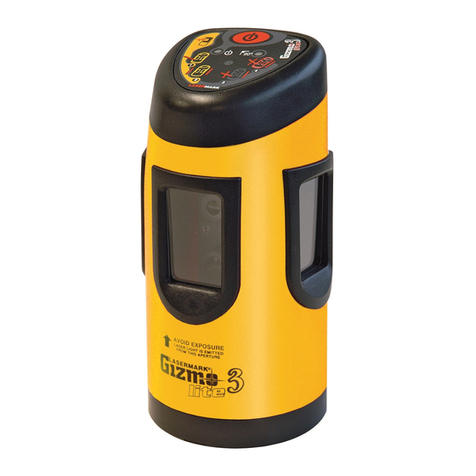
CST/BERGER
CST/BERGER LASERMARK GIZLT-3 User manual
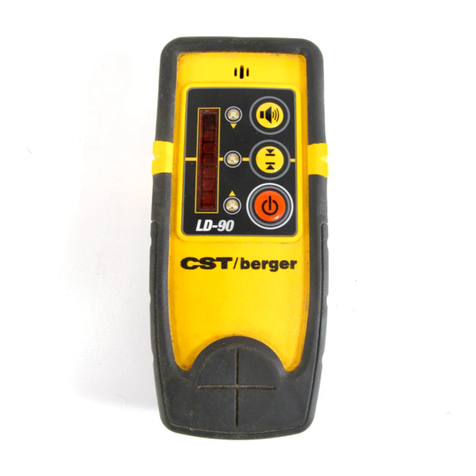
CST/BERGER
CST/BERGER LD90 User manual
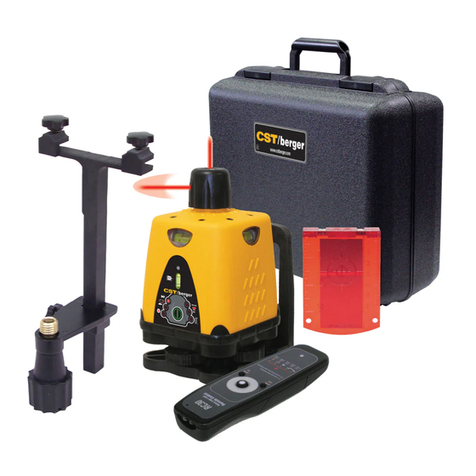
CST/BERGER
CST/BERGER LM30 User manual

CST/BERGER
CST/BERGER RL25H User manual

CST/BERGER
CST/BERGER Lasermark LD500 User manual
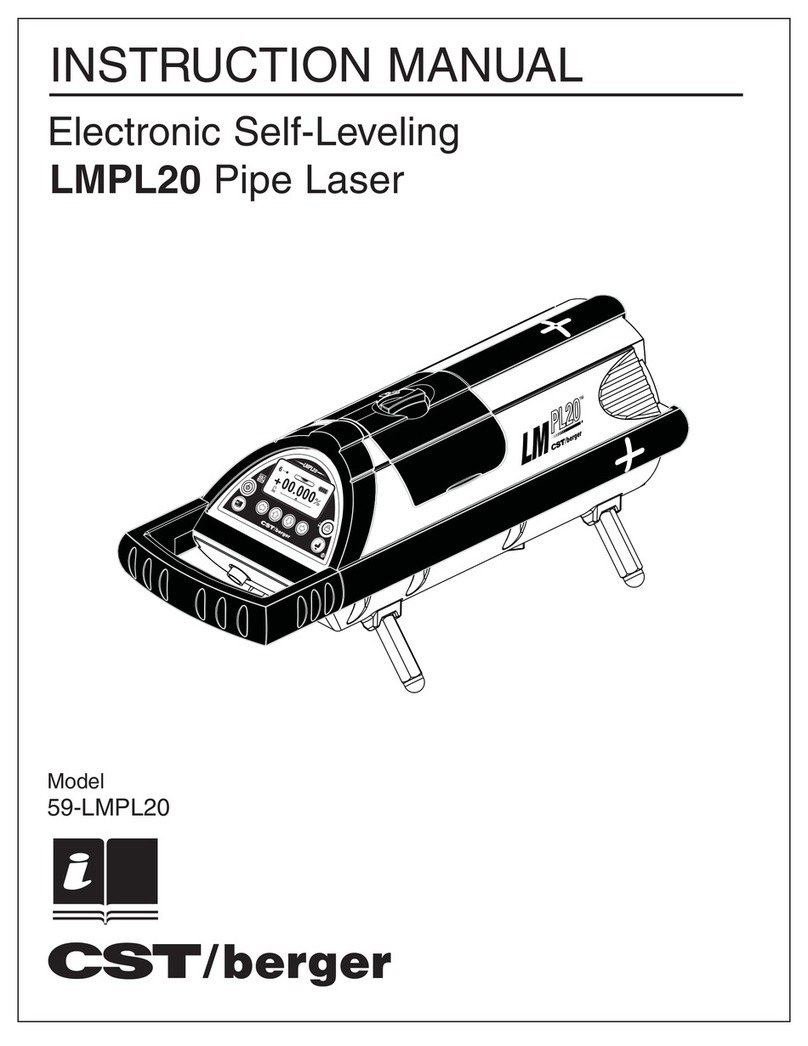
CST/BERGER
CST/BERGER LMPL20 User manual
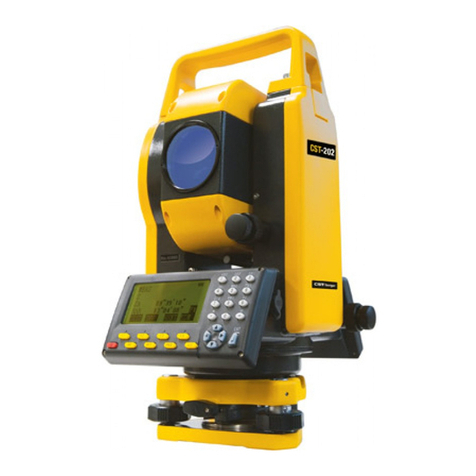
CST/BERGER
CST/BERGER CST202 User manual
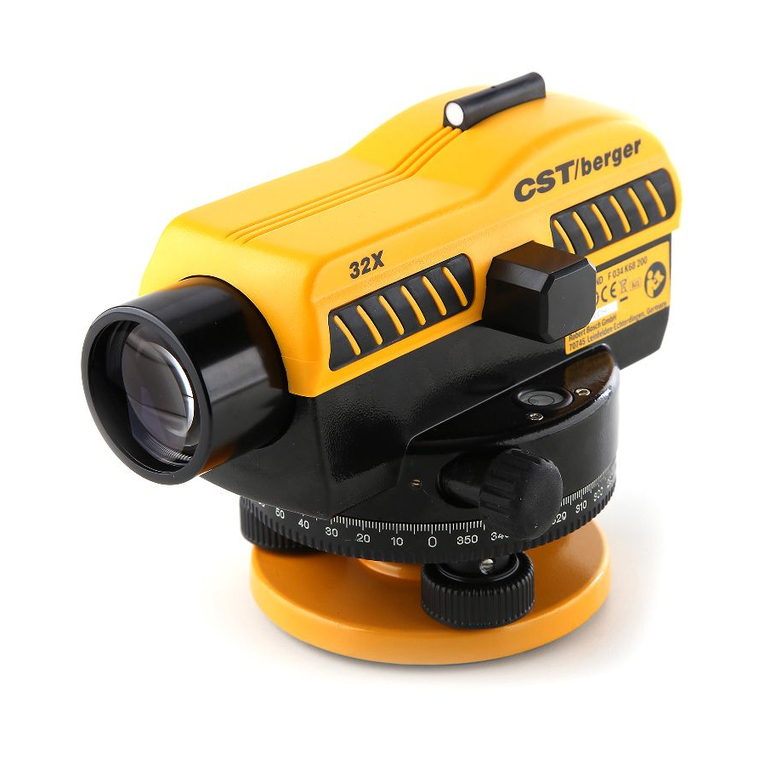
CST/BERGER
CST/BERGER PAL/SAL N Series User manual
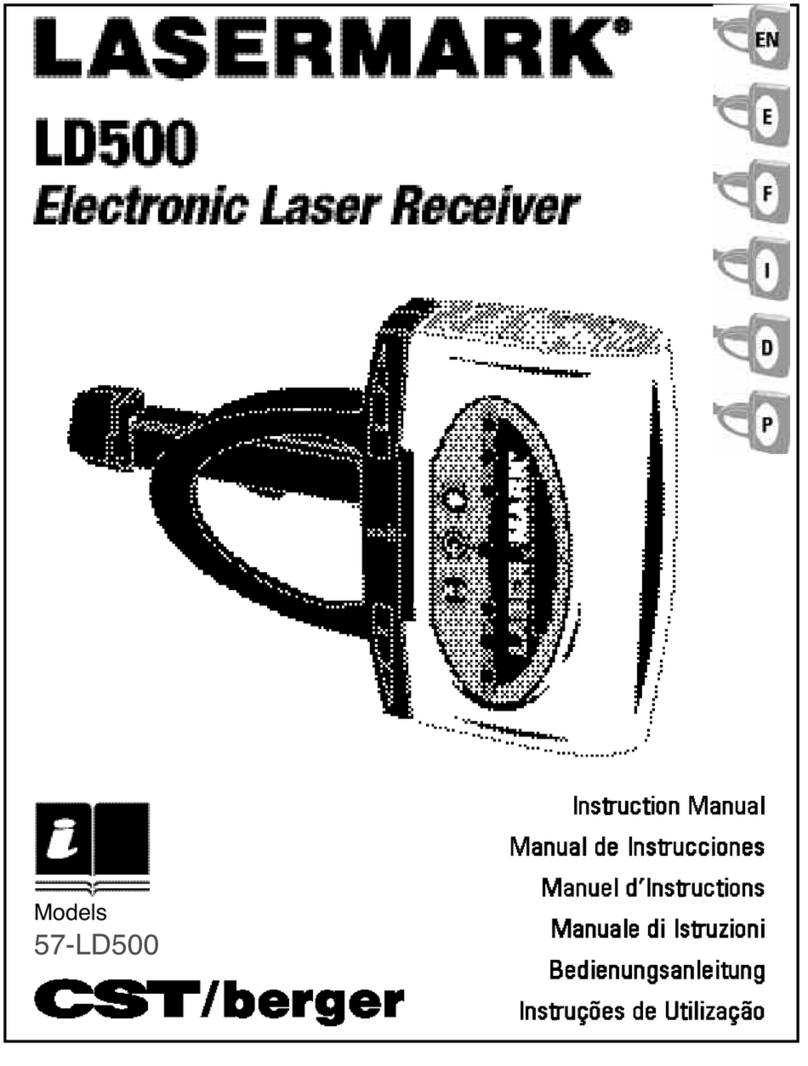
CST/BERGER
CST/BERGER Lasermark LD500 User manual

CST/BERGER
CST/BERGER iLMXT User manual
